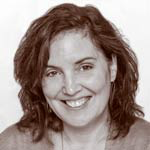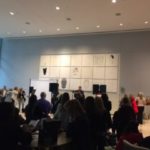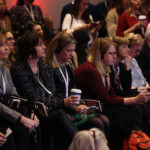 Last week, the TED2015 conference unfolded at the Vancouver Convention Centre for the second time since the event moved there from California last year, so it was a treat when TED’s director of events, Janet McCartney, took time out of her packed schedule to drop in on a TED simulcast at Vancouver’s Morris J. Wosk Centre for Dialogue. (Convene was in the audience, part of a TED-inspired press trip about which we’ll write more in coming days).
Last week, the TED2015 conference unfolded at the Vancouver Convention Centre for the second time since the event moved there from California last year, so it was a treat when TED’s director of events, Janet McCartney, took time out of her packed schedule to drop in on a TED simulcast at Vancouver’s Morris J. Wosk Centre for Dialogue. (Convene was in the audience, part of a TED-inspired press trip about which we’ll write more in coming days).
 The spiky-haired McCartney, who works on TED alongside her business partner (and twin sister) Katherine McCartney, was succinct and efficient as she ran through her list of “fundamentals” for producing a successful event as innovative and far-reaching as TED. While her own talk was much less than 18 minutes, it was — like the conference itself — dense with big ideas.
The spiky-haired McCartney, who works on TED alongside her business partner (and twin sister) Katherine McCartney, was succinct and efficient as she ran through her list of “fundamentals” for producing a successful event as innovative and far-reaching as TED. While her own talk was much less than 18 minutes, it was — like the conference itself — dense with big ideas.
Adaptability and attention to nuance. “Everything changes at TED all of the time,” said McCartney, referring to the TED team’s penchant for real-time adjustment of their plans up until the moment that conference begins. “There’s no manual to produce an event of this scale,” she added, and nothing is ever black or white. Rather, desired outcomes help shape moment-to-moment decisions: “What is the opportunity? What is the goal?”
Vision and smart collaboration. McCartney and her staff hew to “a really strong global vision of what we’re doing,” as they plan each event. Because they’re constantly looking beyond the microcosm of the conference itself, TED asks partners to think big and “stretch themselves.” That means the organization seeks out “the brightest minds around,” such as architect David Rockwell, who designed the semi-circular, custom TED theater used for the talks. “There’s nothing inelegant about [the theater],” said McCartney, and it combines both magnificence and intimacy — offering attendees a sense that “this is theirs, and theirs alone.”
Persistence, tenacity, and grit. With TED, as with any event that happens year after year, “there’s a lot of repetition,” said McCartney. So the organization works to keep their employees comfortable and engaged — ordering in delicious food, for example — during a grueling three-month period before the event, a time when they might hardly see families or friends. And with 110 TED team members working in New York City, McCartney quipped that she and her Vancouver team needed to have ample ‘tude to match theirs. “No is never no.”
Curious for a deeper glimpse into producing the TED conference? Check out our interview with Katherine McCartney in the April issue of Convene, online late next week. Also check out “4 Lessons Every Meeting Planner Should Take From TED’s Content Strategy,” on pcma.org.





